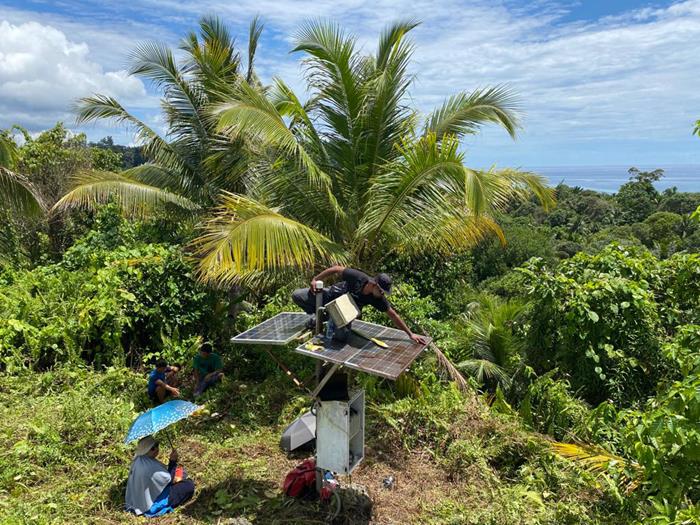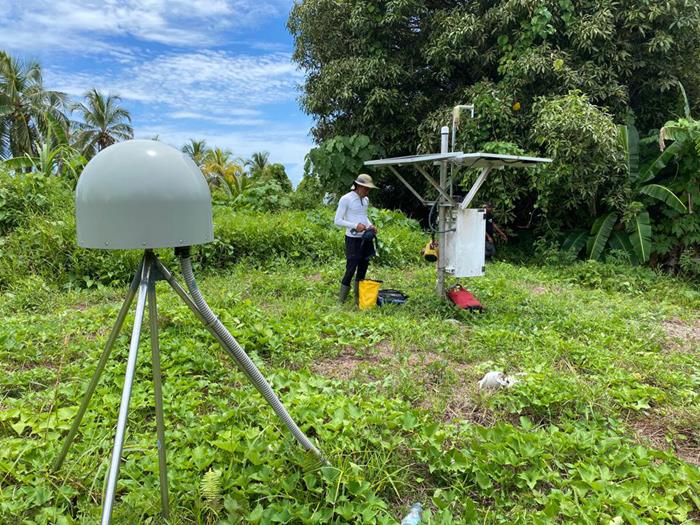In this blog series, we follow scientists from the Centre for Geohazard Observations (CGO) at the Earth Observatory of Singapore as they resume fieldwork activity after a hiatus due to the pandemic. During this first trip, they aim to maintain several Global Positioning System (GPS) stations of the Sumatran GPS Array (SuGAr) offshore Sumatra, and to install new stations. These stations observe the motion of plate tectonics along the Sunda megathrust, the plate boundary fault between the Indo-Australian plate and the Eurasian plate that has generated many great earthquakes. The CGO team ensures that the stations continue to observe the region’s tectonic activity, which ultimately helps prepare for the next earthquake.
After some successful days in Sipora island where the team looked after four stations, the next stop was further south, in the North Pagai island.

Scientists from the EOS Centre for Geohazard Observations and their collaborators waiting for their boat to ferry them to the locations of the next stations (Source: Juniator Tulius/Earth Observatory of Singapore)
The first two stations, SMGK and SLBU, presented no difficulty and the team completed the job within a few hours. It was then time for a well-deserved rest and some fishing in nearby Sikakap, a small village where the team would stay during their stay in North Pagai.
The next day, the team split into two groups. One team headed to Parakbatu village where the PRKB station is located, while the other team went to maintain the BSAT station in Bulasat village. At the PKRB station, after being welcomed by some curious local children, they cleaned the solar panels, replaced the batteries, and downloaded the data.
These downloaded data play an important role in ensuring a more complete dataset. Even though the stations automatically send the data via telemetry to the CGO and to our collaborators from Pusat Riset Kebencanaan Geologi in Indonesia so that the agencies can observe the region’s tectonic activity in near real-time, a range of problems can lead to missing data in the records. For instance, failures of the power supply can cause the data transmission to fail. In these cases, the downloaded data can fill up any gaps in the record which improves our observations.

A member of the maintenance team cleans solar panels that provide energy to the GPS station (Source: Juniator Tulius/Earth Observatory of Singapore)
It was then already time to head back north. The team left Sikakap to get back to Tuapejat, for their final stretch of the trip in the Mentawai Islands. They embarked on two wooden boats for a four-hour long journey.
In Tuapejat, they performed a final check on SIOB, a station they had serviced the week before but was showing error messages, to ensure that it was working properly. While in the area, they also serviced an additional station on Pulau Panjang, PPNJ, close to Tuapejat.

CGO scientist next to a GPS station from the SuGAr network (Source: Juniator Tulius/Earth Observatory of Singapore)
Once the nine stations were serviced, the field trip in the Mentawai Islands reached its end. The team departed to Padang Island, but their SuGAr network adventures were not over. The SuGAr network is a network of GPS stations located in the islands offshore Sumatra as well as in Sumatra and Java. Maintenance of existing stations is key to observing the region’s tectonic activity, as is the installation of additional stations that provide the much-needed data to unravel the complexity of the activity.
Next, the team will head to Bandung, where they will be installing new stations. Stay tuned to the EOS blog to find out more.
This work related to the maintenance of SuGAr stations located in Mentawai Islands is done in collaboration with Pusat Riset Kebencanaan Geology at the National Research and Innovation Agency (BRIN) in Indonesia.